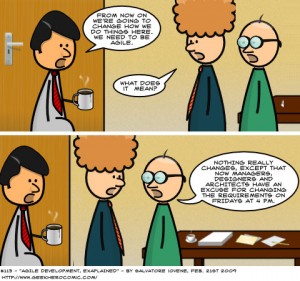Agile Service Request Management
Given that agile approaches can improve productivity and quality, now may be the time to examine the agility of your service request management system.
Merriam-Webster defines agile as “marked by ready ability to move with quick easy  grace; having a quick, resourceful and adaptable character.” In software terms, agile has come to mean methodologies with those same characteristics and adherence to the famous Agile Manifesto first articulated in 2001. Most agile methodologies exhibit some combination of the following characteristics:
grace; having a quick, resourceful and adaptable character.” In software terms, agile has come to mean methodologies with those same characteristics and adherence to the famous Agile Manifesto first articulated in 2001. Most agile methodologies exhibit some combination of the following characteristics:
- They’re flexible and designed to accommodate change.
- Work is done is short iterations with the goal of producing usable results fast.
- They standardize on a common communication protocol and data model.
- They can easily be modified and are scalable by design.
What’s not to like? Survey after survey shows that agile has really gone mainstream. Seventy to eighty percent of respondents in a couple of recent surveys used agile methodologies. And nearly all reported improved productivity, quality, time-to-market, business value, and project success rates.
An Agile approach to Request Management
Now may be the time to examine the agility of your service request management system. After all, conventional methods for designing and deploying complex service requests can take weeks or month, as administrators labor to map new workflows to existing processes without negatively impacting the overall business logic of the underlying IT service management platform. This slows both adoption rates and time to value, and as request management needs change across the enterprise, limits speed and flexibility.
There’s an agile way to do it. It looks like this:
- Instead of coding, service requests and forms are created by cloning and modifying existing processes or configuring re-usable templates. This means they can be rapidly created, scaled and expanded across the enterprise.
- Instead of relying on IT, non-IT administrators have control over the request management workflows and processes. This makes it easier to keep pace with continually changing user needs.
- Instead of being tied to one IT service management (ITSM) platform, request management processes can be integrated with any corporate ERP, HRM, CRM or ITSM system and are usable by anyone who has basic familiarity with those systems. This means you can scale across the enterprise.
By that definition, Kinetic Request bundled with Kinetic Task is the ideal agile approach to service request management. With Kinetic Request, creating, testing and deploying service items is a simple, iterative process that avoids the expense and delays of traditional software development processes and delivers functional applications to business users quickly, anywhere in the enterprise. That’s the very soul of agile.



